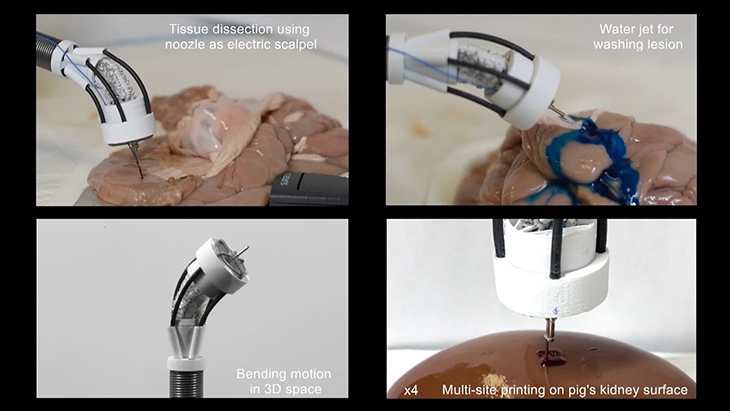
Incredible advancements have been made in robotics, as evidenced by the latest device developed by some engineers from the University of New South Wales, Sydney. This new device works just like a three-in-one surgical tool that can also 3D-print living cells inside the human body, in real time.
The device uses a scalpel, a water jet, and an endoscopic camera while performing multiple surgical functions. 3D bioprinting is a process where biomedical parts are fabricated from so-called “bioink” to form natural tissue-like structures.
Bioprinting happens to be a technology that is predominately used for research purposes, like tissue engineering and the development of new drugs. It also normally requires the use of large 3D printing machines in order to produce cellular structures outside of the living body.
This new research, led by Dr. Thanh Nho Do and his PhD student, Mai Thanh Thai, from UNSW Medical Robotics Lab, was also done in collaboration with other researchers from UNSW.
The research team has produced a tiny, flexible 3D bioprinter that can be inserted into the body like an endoscope and deliver multilayered biomaterials directly onto internal organs and tissues.
The blueprint device, known as F3DB, has a maneuverable swivel head that prints the bioink, and is attached to a long and flexible robotic arm that can be externally controlled. The team tested the device inside an artificial colon, managing to get through the highly confined spaces and was able to successfully 3D print on its surface.
With further development, the research team is hopeful that within five to seven years, the technology may be usable by medical professionals to access hard-to-reach areas within the body using small skin incisions or natural orifices.
Dr. Do and his research team tested the device inside an artificial colon, and have also done 3D printing on a number of materials with different shapes upon the surface of a pig’s kidney.
Dr. Do explained, “Existing 3D bioprinting techniques require biomaterials to be made outside the body and implanting that into a person would usually require large open-field open surgery which increases infection risks.”
“Our flexible 3D bioprinter means biomaterials can be directly delivered into the target tissue or organs with a minimally invasive approach. This system offers the potential for the precise reconstruction of three-dimensional wounds inside the body, such as gastric wall injuries or damage and disease inside the colon.”
The next stage of development for the system – which has already been given a provisional patent – is in vivo testing on living animals to exhibit its practical use.
In addition, the researchers intend to incorporate further functionalities, including an integrated camera and scanning system that operates in real-time, to create a 3D tomographic image of the moving tissue inside the body.
See more about this 3D machine in the video below.



